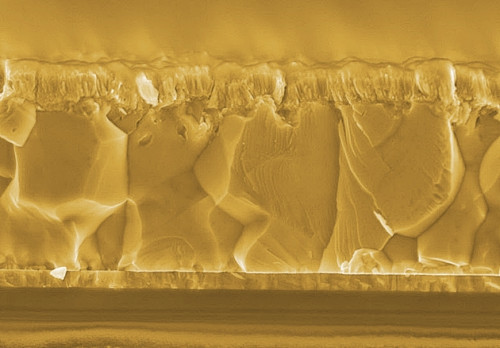So-called bifacial thin-film solar cells based on copper indium gallium diselenide (CIGS) can capture solar energy on both the front and back surfaces and therefore potentially generate more solar power than conventional solar cells.
So far, however, their production has only allowed relatively low efficiencies in energy conversion. An Empa team has now developed a new low-temperature production process that enables record efficiencies of 19.8 % for the front side and 10.9 % for the back side. They have also produced the first bifacial perovskite CIGS tandem solar cell, which could enable even higher energy yields of over 33 % in the future.
 Bifacial CIGS solar cells consist of extremely thin layers, only 3 µm in total for the active materials. The polycrystalline CIGS layer is applied to a transparent electrical contact and absorbs the light from both the front and the back (Image: Empa)
Bifacial CIGS solar cells consist of extremely thin layers, only 3 µm in total for the active materials. The polycrystalline CIGS layer is applied to a transparent electrical contact and absorbs the light from both the front and the back (Image: Empa)
In the new low-temperature process, a small amount of silver is added to the CIGS layer, which significantly lowers the melting point of the CIGS alloy. As a result, the formation of a gallium oxide interface caused by oxidation of the gallium present in the CIGS, which blocks the flow of solar electricity and reduces the energy conversion efficiency of the cell, can be practically prevented.


